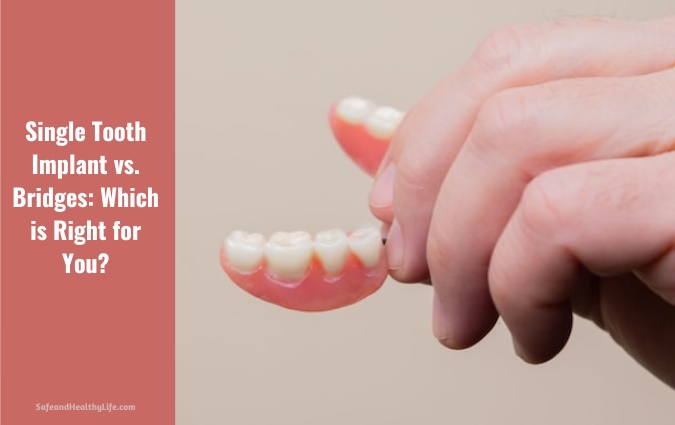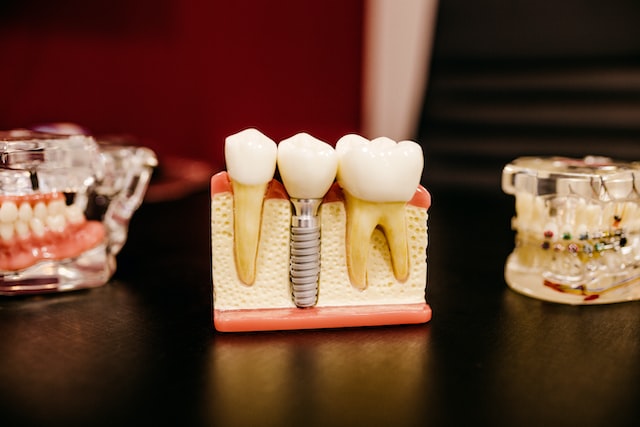
The loss of a tooth can be extremely upsetting and distressing for a variety of reasons, including the obvious visual effects and the inability to eat and speak normally.
Single-tooth implants and bridges are two of the most common ways to replace lost teeth.
This post will go over the benefits and drawbacks of each choice so you can make an informed decision, click here to learn more.
Key Takeaways:
- A dental crown is placed on top of a titanium screw that is surgically implanted into the jawbone during a single-tooth implant operation to replace a missing tooth’s root.
- A single-tooth implant is a permanent treatment that mimics the appearance and function of a natural tooth, protects the integrity of the surrounding teeth, and minimizes or eliminates the need for any dental restorations.
- The primary disadvantages of a single-tooth implant are the higher price and lengthier treatment duration.
- A dental bridge is a prosthetic tooth that spans the gap left by one or more missing teeth and is cemented to the adjacent teeth, which have been altered or “prepped” by the removal of a small amount of enamel.
- While a bridge can save you money and save your treatment time, it also comes with some drawbacks, including the need to change or damage adjacent teeth, a shorter lifespan, and an appearance and functionality that don’t quite match those of a single tooth implant.
- If you’re missing a tooth, your dentist can help you decide whether a bridge or an implant would be the best solution.
- Replacing a missing tooth restores aesthetics and oral health and helps with chewing and speaking.
Single Tooth Implant
To replace the root of a single lost tooth, a surgeon will drill a small hole in the jaw and insert a titanium screw. Dental crowns are placed atop implants once they have integrated with the jawbone to form artificial teeth.
Single-tooth implants are advantageous because they mimic the appearance and performance of natural teeth. As opposed to removable dental prosthetics like dentures or bridges, an implant is fixed to the jaw and hence cannot move about while eating or speaking.
The natural teeth are protected because the implant is a separate construction that doesn’t need to be attached to any other teeth. A single tooth implant not only helps the bone stay healthy but also reduces the risk of bone loss.
Having a permanent solution is another advantage of a single-tooth implant. A single implanted tooth, if well taken care of, has the potential to last a lifetime. That’s why it’s money well spent on your teeth and gums.
However, the expense of a standalone implant is arguably the major disadvantage. In some cases, dental insurance won’t cover the cost of replacing a single missing tooth with an implant.
Furthermore, a single-tooth implant procedure takes more time than other options because it requires many appointments and a healing period after the implant is placed.

Photo Credit: Unsplash
Bridges
When one or more teeth are missing, a bridge can be used as a prosthetic. The teeth on either side of the gap are “prepped” by filing down some of the enamel in order to act as anchors for the bridge. The adjacent teeth are then shaped to receive the prosthetic tooth or teeth, thus “bridging” the gap left by the absent tooth.
The main advantage of a bridge is that it is more cost-effective than implanting a single tooth. A bridge can be placed in as little as two or three appointments, making it a more convenient option for patients.
The most significant disadvantage of using a bridge to replace a missing tooth is that it usually necessitates modifying the adjacent teeth. In the long run, this can worsen your oral health.
In comparison to a single-tooth implant, bridges are less durable, less aesthetically pleasing, and less practical.
| Read also: What are the Health Benefits of Dental Implants? |
Single Tooth Implant vs Bridges
The long-term benefits of a single-tooth implant vs a bridge should be factored into any cost comparison. If you’re looking for a cheaper alternative to a tunnel, consider a bridge instead.
On the other hand, a single-tooth implant has a significantly longer lifespan and may actually end up saving you money.
Two or three appointments are usually all that’s needed to finish a bridge, but a single tooth implant may take multiple visits and a healing period.
A single-tooth implant is the most realistic-looking and practical choice since it mimics the form and function of a natural tooth.
However, a single-tooth implant is more comfortable and secure than a bridge, and it can replace a missing tooth without affecting the surrounding teeth.
Conclusion
The bottom line is that there are pros and cons to both single-tooth implants and bridges. A permanent and aesthetically pleasing option, a single-tooth implant is more costly and takes longer to cure than other options.
Bridges are less expensive and take less time to install, but they might cause damage to the teeth on either side and have a shorter lifespan.
Whether you should get a bridge or an implant for a single tooth depends on your specific situation. For personalized dental care recommendations, it’s better to schedule an appointment with a dentist.
They’ll take into account your jawbone’s condition, the location of the gap, and your financial constraints before recommending a treatment plan.
Replacing a lost tooth is necessary for oral health and proper chewing function. When you lose a tooth, the others may shift out of place, leading to new issues with your bite.
When you lose a tooth, you can restore your smile and your oral health by getting an implant or a bridge.
FAQ:
What are the benefits of a single-tooth implant?
The benefits of a single tooth implant include that it looks and functions like a natural tooth, it is a long-lasting solution, doesn’t require damage to adjacent teeth, and preserves the natural teeth.
What are the drawbacks of a single-tooth implant?
The main drawback of a single-tooth implant is its cost and longer treatment time.
What is a bridge?
A bridge is a dental prosthetic that is used to replace one or more missing teeth. The bridge is anchored to the surrounding teeth, which are usually modified or “prepared” by removing a portion of the enamel. The replacement tooth (or teeth) is then attached to the prepared teeth on either side, effectively “bridging” the gap created by the missing tooth.
What are the benefits of a bridge?
The main benefit of a bridge is its cost and shorter treatment time.
What are the drawbacks of a bridge?
The drawbacks of a bridge include that it requires damage or alteration of surrounding teeth, has a shorter lifespan, and is less natural-looking or functional than a single tooth implant.
How do I decide between a single tooth implant and a bridge?
The choice between a single-tooth implant and a bridge will depend on individual needs and circumstances and it is important to consult with a dental professional. They will consider factors such as the health of your jawbone, the position of the missing tooth, and your budget to help you make an informed decision.
Why is it important to replace a missing tooth?
Replacing a missing tooth is important to maintain the health and function of the mouth. A missing tooth can shift the remaining teeth, which can cause further oral health problems. Replacing a missing tooth with either a single tooth implant or a bridge can restore your smile and improve your ability to speak and chew properly.
About The Author:
Stacey Smith is a freelance health writer. She is passionate to write about women’s health, dental health, diabetes, endocrinology, and nutrition and provides in-depth features on the latest in health news for medical clinics and health magazines.



![3 Breathing Techniques Which Relieve Anxiety [And The Science Behind Them] Breathing Techniques Which Relieve Anxiety](https://www.safeandhealthylife.com/wp-content/uploads/2021/09/Breathing-Techniques-Which-Relieve-Anxiety-150x150.jpg)
